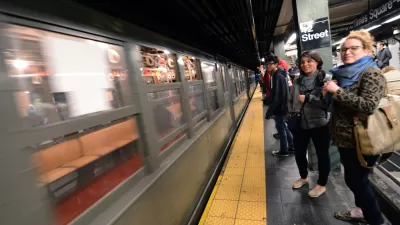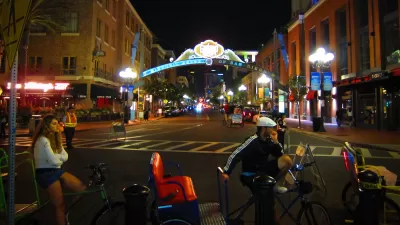Despite significant investment in transit infrastructure, and renewed interest in downtowns and walkable neighborhoods, new data shows that gains in transit commute mode share have been hard to come by in America’s largest cities, says Kaid Benfield.
"As most readers know only too well, the US pales by comparison to the rest of the world when it comes to getting around by anything other than single-occupancy cars," writes Benfield in a recent blog post. He adds, "[s]lowly but surely, the trend is now beginning to reverse as the hot markets are in downtowns and walkable neighborhoods, with the ones having good transit service commanding the highest premiums on a per-square-foot basis."
Despite these new trends, Benfield finds mixed results in the findings of a recent analysis examining 2011 American Community Survey results regarding metropolitan commuting patterns. Only New York City and Washington D.C, who lead in general transit usage with commute mode shares of 31.1 percent and 14.8 percent, respectively, significantly increased their transit mode shares in the last decade. New York, Boston and San Francisco all led the way in walking to work, with shares of 6.3 percent, 5.3 percent and 4.3 percent, respectively.
Nationwide, bike commuting is still relatively low, with most cities registering fewer than 2 percent shares. Portland (topping the list) and three Californian cities (the Bay Area, San Jose/Silicon Valley, and Sacramento) were the exceptions. Of interest, notes Benfield, is the finding that the 10 longest commutes all average around 30 minutes, a statistic that "has been fairly stable for centuries; only the modes and distances have changed."
FULL STORY: Which US metros have the greenest commuting habits?

Planetizen Federal Action Tracker
A weekly monitor of how Trump’s orders and actions are impacting planners and planning in America.

Maui's Vacation Rental Debate Turns Ugly
Verbal attacks, misinformation campaigns and fistfights plague a high-stakes debate to convert thousands of vacation rentals into long-term housing.

Restaurant Patios Were a Pandemic Win — Why Were They so Hard to Keep?
Social distancing requirements and changes in travel patterns prompted cities to pilot new uses for street and sidewalk space. Then it got complicated.

In California Battle of Housing vs. Environment, Housing Just Won
A new state law significantly limits the power of CEQA, an environmental review law that served as a powerful tool for blocking new development.

Boulder Eliminates Parking Minimums Citywide
Officials estimate the cost of building a single underground parking space at up to $100,000.

Orange County, Florida Adopts Largest US “Sprawl Repair” Code
The ‘Orange Code’ seeks to rectify decades of sprawl-inducing, car-oriented development.
Urban Design for Planners 1: Software Tools
This six-course series explores essential urban design concepts using open source software and equips planners with the tools they need to participate fully in the urban design process.
Planning for Universal Design
Learn the tools for implementing Universal Design in planning regulations.
Heyer Gruel & Associates PA
JM Goldson LLC
Custer County Colorado
City of Camden Redevelopment Agency
City of Astoria
Transportation Research & Education Center (TREC) at Portland State University
Jefferson Parish Government
Camden Redevelopment Agency
City of Claremont




























